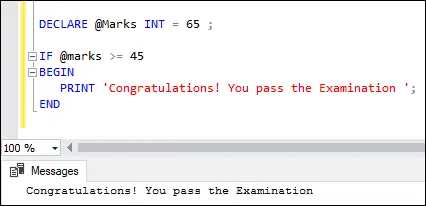Az IF utasítás az SQL Server vezérlőfolyamat-függvényének része. Általában ez egy döntéshozó nyilatkozat a különböző programnyelveken értéket ad vissza a megadott feltételek alapján . Ez az utasítás végrehajtja az IF blokkban írt kódot, amikor az adott feltétel kiértékelése igaz, és ha a feltétel hamis, akkor az ELSE utasítás kerül végrehajtásra.
prioritási sor c++
Az IF nyilatkozat
A következő szintaxis illusztrálja ennek az utasításnak az SQL Serverben való használatát:
IF boolean_expression BEGIN { statement_block } END A fenti szintaxisban a nyilatkozat_blokk ban,-ben KEZDÉS...VÉGE blokk akkor kerül végrehajtásra, amikor a logikai_kifejezés elégedett az állapottal. Ellenkező esetben ez a mondat kimarad, és a programvezérlő a következő utasításra kerül VÉGE kulcsszó. Tudnunk kell, hogy ha a kifejezés tartalmazza a KIVÁLASZTÁS nyilatkozatot, szükségünk van rá zárójelben tedd őket .
Példa
Lássuk a példát, hogy megértsük az IF utasítást ELSE blokk nélkül. Az alábbi példa megjeleníti az eredményt, ha a feltétel teljesül. Ellenkező esetben a programvezérlő az END kulcsszó utáni utasításra költözött, ha van ilyen.
DECLARE @Marks INT = 65 ; IF @marks >= 45 BEGIN PRINT 'Congratulations! You pass the Examination'; END
Az utasítás végrehajtása az alábbi kimenetet adja:

Most bemutatjuk az alábbiakban Diák' táblázat a következő adatokkal:

Az alábbi egy másik példa arra, hogy a összpontszám egy kiválasztott diák a ' Diák' táblázatot a mintaadatbázisban, majd kinyomtatja a üzenet ha az 400-nál nagyobb .
példánya java-ban
BEGIN DECLARE @Total_Marks INT; SELECT @Total_Marks = total_marks FROM Student WHERE age>25; SELECT @Total_Marks; IF @Total_Marks > 400 BEGIN PRINT 'Congratulations! You pass the Examination'; END END
Az alábbi kimenetet kapjuk:

Ha látni szeretnénk a fenti kimeneti üzenetet, kattintsunk a üzenetek lap:

Az IF-ELSE nyilatkozat
A valós forgatókönyvben végre kell hajtanunk valamilyen műveletet, amikor az IF utasításban szereplő feltétel IGAZ vagy HAMIS. Ebben az esetben az IF…ELSE utasítás hasznos. Ez az utasítás végrehajtja az ELSE utasításblokkot, ha az IF záradék feltétele FALSE-ra van értékelve.
A következő szintaxis az IF ELSE utasítás használatát szemlélteti az SQL Serverben :
IF expression BEGIN Statement block -- It executes when the IF clause expression is TRUE. END ELSE BEGIN Statement block -- It executes when the IF clause expression is FALSE. END
Példa
Lássuk a példát, hogy megértsük az IF utasítást ELSE blokkal. Az alábbi példa a következő üzenetet jeleníti meg: Gratulálunk! Sikerült a vizsgán ' ha az IF feltétel teljesül. Ellenkező esetben jelenítse meg Megbuktál! Legközelebb több szerencsét '.
DECLARE @Marks INT; SET @Marks = 65; IF @marks <45 begin print 'congratulations! you pass the examination'; end else 'you are failed! better luck next time'; < pre> <p>Executing the statement will give the below output. Here, the <strong>marks</strong> variable is <strong>65</strong> , and the <strong>condition (65<45)< strong> is not satisfied. Therefore, the message inside the ELSE block is displayed:</45)<></strong></p> <img src="//techcodeview.com/img/sql-server-tutorials/49/sql-server-if-else-5.webp" alt="SQL Server IF ELSE"> <p>We will get this output because the condition <strong>(65>45)</strong> is satisfied. Therefore, the message inside the IF block is displayed:</p> <img src="//techcodeview.com/img/sql-server-tutorials/49/sql-server-if-else-6.webp" alt="SQL Server IF ELSE"> <p>Now, we will demonstrate the IF ELSE statement on the above ' <strong>Student'</strong> table. In this example, we are going to check whether the student <strong>total marks</strong> is <strong>greater than or equal to 400</strong> or not as follows:</p> <ul> <li>When the IF condition is TRUE, we will get the student records whose total marks are greater than or equal to 550.</li> <li>If the condition is FALSE, we will get the student records whose total marks are less than 550.</li> </ul> <p>Here is the program:</p> <pre> DECLARE @Marks INT; SET @Marks = 600 ; IF @Marks >= 550 BEGIN SELECT id, name, gender, age, total_marks FROM Student WHERE total_marks >= 550 ORDER BY age ASC END ELSE BEGIN SELECT id, name, gender, age, total_marks FROM Student WHERE total_marks <550 order by age asc end < pre> <p>In this code, we have specified the <strong>@Marks</strong> variable to <strong>600</strong> , and the condition (600 >= 550) is satisfied. Therefore, we will get the output where student records whose total marks are greater than or equal to 550 are displayed.</p> <img src="//techcodeview.com/img/sql-server-tutorials/49/sql-server-if-else-7.webp" alt="SQL Server IF ELSE"> <p>If we changed the <strong>@Marks</strong> variable to <strong>500</strong> and the condition (500 >= 550) becomes false. Therefore, we will get the output where student records whose total marks are less than 550 are displayed.</p> <img src="//techcodeview.com/img/sql-server-tutorials/49/sql-server-if-else-8.webp" alt="SQL Server IF ELSE"> <h2>Nested IF ELSE Statement</h2> <p>Unlike other programming languages, we can nest an IF...ELSE statement inside another IF...ELSE statement in SQL Server. Let us demonstrate it with the following example:</p> <pre> DECLARE @age INT; SET @age = 6; IF @age <18 50 print 'you are underage'; else begin if @age < below 50'; senior cetizen'; end; pre> <p>In this example, we are going to check whether the <strong>age is underage, below 50, or senior citizen</strong> as follows:</p> <ul> <li>If the value of the <strong>@age</strong> variable is below <strong>18</strong> , it will print the person is <strong>underage</strong> .</li> <li>If the condition is FALSE, the ELSE part will be executed that has a nested IF…ELSE.</li> <li>If the value of the <strong>@age</strong> variable is under <strong>50</strong> , it will print <strong>below 50</strong> . Finally, if no condition is satisfied, it will print <strong>senior citizens</strong> .</li> </ul> <p>Here is the result:</p> <img src="//techcodeview.com/img/sql-server-tutorials/49/sql-server-if-else-9.webp" alt="SQL Server IF ELSE"> <p>This article gives a complete overview of how to use the SQL Server IF ELSE statement. Here we have learned:</p> <ul> <li>Variables are objects that serve as placeholders.</li> <li>The keyword BEGIN will be used to start a statement block, and the END keyword must be used to close it.</li> <li>The use of ELSE in an IF... ELSE statement is optional.</li> <li>It's also possible to nest an IF...ELSE statement inside another IF...ELSE statement. However, nesting an IF statement within another statement is bad practice because it makes the code difficult to read and maintain.</li> </ul> <hr></18></pre></550></pre></45>
